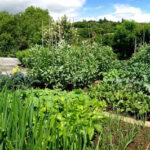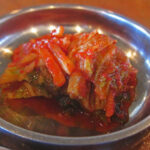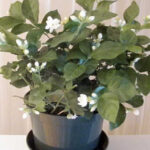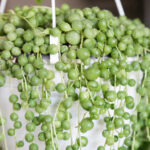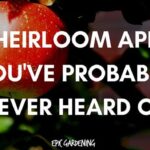Imagine an ancient stone cottage surrounded by a formal garden with English ivy covering the walls. A fantastic climbing vine, it develops rootlets as it grows, allowing it to cling to stone, wood, or nearly anything else. Over time, it spreads and covers a wall or fence.
And yet there are problems. Not only will it cover the side of your house, but if left untamed, it will conquer your entire property. It is an invasive species after all.
Learn how to keep English ivy contained here! It is an invasive species that can devour everything in its path.
Top Products to Help You Grow Common Ivy:
English Ivy Overview
| Common Name | English ivy |
| Scientific Name | Hedera helix |
| Family | Araliaceae |
| Light | Partial to full shade preferred |
| Water | Water container plants in dry conditions, and .5 to 1” per week for in-ground plants; keep the soil moist |
| Soil | Well-drained but rich soil |
| Fertilizer | Do not fertilize this invasive species, especially in British Columbia |
| Pests | Spider mites, aphids, scale insects |
| Diseases | Root rot and stem rot, leaf spots, anthracnose, sooty mold, powdery mildew |
All About English Ivy
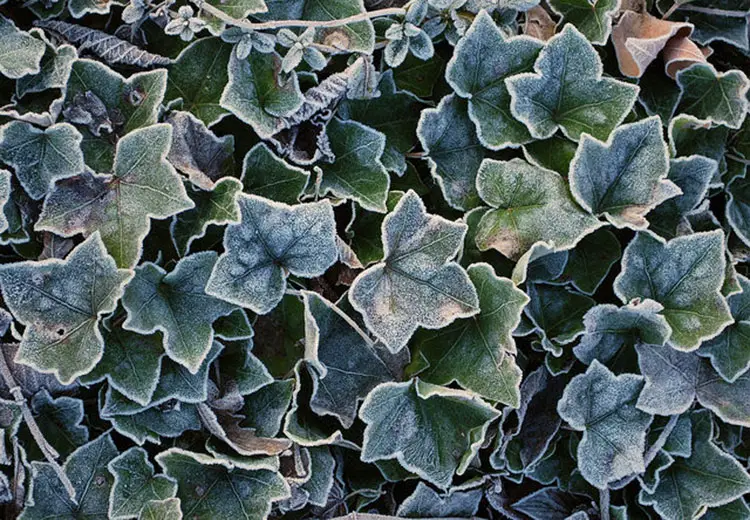
Botanically, English Ivy is called Hedera helix. The term, helix, is derived from the Greek word “twist” or “turn”, as the vines do as they grow. Its synonyms are tree ivy (Hedera arborea), Hedera baccifera, Hedera acuta, and Hedera grandifolia.
All forms of European ivy climb upwards via rootlets along the vine. These cling to many surfaces, and many ivies are classed as invasive species. Check with your local extension office before planting English ivy. The evergreen vines cling to rough or uneven surfaces, which are easier to grasp onto. Darker, moist surfaces are preferred.
Many places ban the sale of English ivy, like British Columbia for instance. It’s an invasive species in these areas. It’s an evergreen vine that climbs up tree trunks and overtakes the canopy of trees, causing them to suffer from lack of light and die off. Further, it chokes out seedlings.
That tendency prevents growth of ground-dwelling natives as well. This wreaks havoc on local ecosystems. It spreads via its vines, and each of its berries has up to five seeds within. These are carried for miles by birds, spreading vines far and wide. Be careful when planting this invasive species.
In the United States, English ivy is banned from sale throughout the Pacific Northwest, where it is a horribly invasive species. Outside the Pacific Northwest, other states have bans due to its invasive species classification. However, you’ll find it growing even in locations where it’s banned. It is widely planted as a ground cover or decorative plant.
It’s advised that if you’re in a region where there’s English ivy growing, resist growing it. It’s pretty, but it is a major problem! Can’t resist? Monitor your English ivy closely. Remove fruit before it ripens. Keep it trimmed, and either hot-compost or throw away clippings.
English ivy growing in containers is okay in most of these areas as long as correct methods are followed. But be mindful and make sure it doesn’t spread locally. It makes a fantastic house plant, even where it’s an invasive species. Most people think growing it as an indoor plant is an absolute joy.
Here’s a video Kevin recorded about ivy growing indoors as a houseplant (the only way he personally grows it):
English ivy cleans your air when it’s grown indoors, and it’s great as a privacy fence or green wall year round in your garden. If it’s well maintained, it’s great for a yard. A privacy fence may be formed of a trellis over top of a raised bed, or a chain-link fence.
Traditionally, English ivy was used to coat the walls of homes or other buildings, as it keeps homes cooler in summer and warmer in winter this way. However, if there are any cracks where you’re growing English ivy, the rootlets grow into them and cause damage.
Miniature cultivars of English ivy are great as evergreen ground cover. If it’s trimmed growing English ivy rarely leads to fruiting. English ivy may have use in fire-prone areas as a prevention method. The green, moist leaves with their waxy coating remain so year round and do not as catch fire as quickly.
Types Of English Ivy
It’s estimated that across the different English ivy plant species, there are nearly 400 different species altogether. These may be variegated or a range of dark to light green year round. Those cultivars are mostly from three subspecies, each with slightly different origins and growth patterns. Those subspecies are:
- Hedera helix helix: The original English ivy, this plant species originates in central, northern, and western Europe. Plants do not form rhizomes. Berries are purplish-black.
- Hedera helix poetarum Nyman: Throughout Italy, Turkey, and the Balkans and portions of southeastern Asia, this non-rhizomatic English ivy grows. Fruit is bright orange-yellow.
- Hedera helix rhizomatifera McAllister: Found in southeastern Spain, this variety produces rhizomes. It develops new roots even if the smallest cutting remains. Fruit ranges from purple to black.
There are a pair of closely-related ivy plant species. Both are part of the Hedera family, but neither is a true English ivy. Irish ivy is the most similar of these. Some are invasive cultivars.These species are Hedera canariensis (Canarian ivy) and Hedera hibernica (Atlantic or Irish ivy). They have different leaves, but a similar habit. Both the Canarian and Irish ivy species are grown the same.
English Ivy Care
With the above section in mind, here’s a list of ideal conditions for English ivy. For all of its properties as an invasive species, it’s stunning even as an invasive plant!
Light & Temperature
If you are growing English ivy indoors, it does well in bright, indirect lighting. The variegated cultivars prefer more light than the solid green ones. South or west-facing windows may dry the plant, especially in midsummer. At these times of year, indirect lighting from a north or east-facing window is enough.
Using grow lights? Opt to keep your English ivy far enough away that heat from the lights doesn’t dry the leaves with their waxy coating. It also appreciates T5 grow lights if you’d prefer. If you’re growing English ivy outdoors, put it in partial sun or shade, in areas that are shady during the afternoon. Temperatures of 65-85° Fahrenheit are perfect. Heat above 90° can cause poor growth and dieback.
Water & Humidity
Container-grown English ivy plants need a check before watering. If your container has mostly dry soil, water thoroughly until water comes out the base of its container. Allow the soil to dry out mostly before the next watering. Young plants require more water than older ones. Keep the soil moist around young plants until established.
In the summer, English ivy requires more water, especially in full sun. Raise humidity around the plant by placing a pebble bowl with water nearby. If your ivy is planted directly in the ground, its root system goes deep enough that it shouldn’t require more than ½” to 1” of water per week.
Soil
Being an invasive species, the vine adapts to any soil type. In a perfect world, it prefers soil with a pH between 6.0 and 7.5. Avoid clay-based soils, as these prevent drainage. If you’re growing indoors, a mix of equal parts perlite, peat moss, and topsoil keeps the soil moist longer.
If you water frequently, opt for planting English ivy plants in a soilless medium, like tree bark or a well drained soil. As stated above, only water when your planting medium is mostly dry.
Fertilizer for English Ivy
Because this is an invasive species that is considered a noxious weed, don’t fertilize outdoors. Indoor plants only need to be fertilized with a high nitrogen plant food while they’re actively growing in the early spring or fall months, about once per month. In summer and late winter when growth slows, avoid fertilizing.
English Ivy Propagation
Propagate English ivy from cuttings or from seed. Viable seed forms in mature berries. Be cautious harvesting them, as the berries are poisonous to humans. Instead start new plants from cuttings. Select a healthy vine, preferably from young growth on older plants. Once you have section, cut it into segments which have leaves, and are cut off above and below the leaf 1-1.5”.
Dip the cut edge below the leaf into rooting hormone and place it in moistened sand. Affix a plastic bag over the container to keep the humidity up around the cutting. Keep the sand moist, but not wet. Your cutting will sprout new growth in about 6-8 weeks.
Repotting Indoor English Ivy Plants
Repot when the English ivy plant dries out quickly, when it’s root-bound, or when the foliage gets top-heavy – usually once a year. Use clay or plastic pots. Avoid using a pot that is much larger than your plant, as this can lead to too much moisture in the soil. Select a pot just large enough to hold the roots.
Always use pre-moistened soil for planting. For a clay pot, soak the pot before planting to promote moisture-retention. Loosen the root ball. Place a mesh screen or old nylons over the drainage holes in the pot, and top with fresh soil to hold the screen in place. Gently spread the roots over the soil in the bottom of the pot, then fill soil in around the roots until just below the pot’s rim. Water the plant until water comes out the base of the pot.
Pruning English Ivies
If your ivy is ground cover, use a mower on its highest height setting, or prune by hand heavily in spring. Trim English ivy along sidewalks or walkways at any time to keep it enclosed. A good pair of shears works for this. Trim ivies grown upright at any time to remove excess growth or shape them to the surface they’re climbing. Indoors, vines become leggy over time. Pinch back or snip off excess growth just above a leaf to make it more visually appealing.
Troubleshooting English Ivy
The biggest problem with growing English ivy is keeping it from becoming overgrown. But are there other issues that arise in the process of English ivy care? Let’s talk about that.
Growing Problems
Dry or browning edges on ivy leaves are caused by overwatering, which can cause fungal root rot issues. This leads to browning leaves and other foliage failures. English ivy plants in dry climates also develop browning, drying leaves. This is especially true of indoor container plants. To increase the humidity, place it on top of or next to a pebble tray with water. You can also get a humidifier for your plants.
Soil additives can also cause leaf-browning. Too much fertilizer in the soil or watering with hard water can create toxicity in the soil. Avoiding this by watering with distilled water, and do not fertilize.
Pests
English ivy attracts spider mites, which thrive in dry conditions, and make a web beneath the leaves. Water appropriately to prevent them. They create small brownish spots on the leaves, and infestations turn whole leaves brown. To combat spider mites as well as aphids, spray neem oil on all surfaces of the plant. The oil smothers eggs and poisons adults.
Another pest of English ivy is scale insects, primarily mealybugs. Like the other pests mentioned above, wipe them out with neem oil, although it’s easier to trim off infected leaves and throw them away.
Diseases
One of the most common is fungal-based root rots and stem rots. Caused by Phymatotrichum omnivorum or Rhizoctonia solani, these thrive if you plant English ivy overly moist media. If your plant appears yellow or brown and there’s no visible signs of pests, it’s likely you’ve developed rot. Repotting in better-draining soil may help, but badly rotted roots require disposal.
Anthracnose is another problem common to English ivy. If there’s no sign of spider mites but your leaves develop brownish spots, this may be the culprit. Spray neem oil over the plant to prevent this, or use sulfur dust on your ivy.
Other fungal leaf spots of different species, such as Ramularia hedericola, Macrophoma spp., Phyllosticta concentrica, Phytophthora spp., and Glomerella cingulata may develop. Use a copper fungicide to eliminate them. Bacterial leaf spots are not uncommon. These respond well to copper fungicide.
Sooty mold may develop on leaves. This is fungal growth from honeydew, which is secreted by aphids and scale. Eliminate the insects, and the grey-black growth will leave. Powdery mildew is a dusty film that is caused by too much moisture on leaves. Avoid watering leaves and give the vine airflow via selective pruning, and powdery mildew will fade.
Frequently Asked Questions
Q: Is English ivy poisonous to humans or animals?
A: Yes. Not only is it an invasive species that is considered a noxious weed, English ivy is poisonous to cats, dogs, and horses. Some sources say cattle and sheep also suffer from eating it. The glue like substance that is the sap can cause contact dermatitis in susceptible people. The leaves and berries are poisonous. Don’t eat this, and keep it away from children and pets!
Q: English ivy produces blue-black berries…are they edible?
A: Birds eat the berries! But if you’re human don’t. The berries cause gastric distress, difficulty breathing, and much worse.
Q: I’m doing everything I “should” be doing and my English ivy is still dying…what’s happening?
A: If you’re giving your plant enough light, watering appropriately, and have the right kind of soil and your ivy is STILL dying, the most likely culprit is spider mites. Check on the underside of leaves for signs.
Q: I have a variegated English ivy plant, but it’s losing its variegation. How do I get it back?
A: Variegated foliage will disappear if it’s not exposed to enough light. Move your plant to an area with more light. New leaves will be variegated. If you plant English ivy in the wrong spot, you can propagate it and plant English ivy in a spot where variegated foliage is possible.
Q: Why is English ivy a problem?
A: Outside of its native range, this plant is an invasive species that is considered a noxious weed. Invasive cultivars are known for causing damage to homes and buildings. Careful where you plant English ivy and check with your local extension office if you’re unsure if it’s invasive in your area, or you may have to take it out with systemic herbicide.
Q: Does English ivy need sun?
A: Plant English ivy in bright, indirect light, but not full sun. Do not place this noxious weed or invasive plant in too much sunlight.
Q: Is English ivy destructive?
A: When it comes to native ecosystems in North America, yes. It’s an invasive species that removes native forage for wildlife. When it comes to home maintenance, this invasive plant can penetrate through walls and cause structural damage.
Q: Can English ivy survive winter?
A: Yes. Because it is an invasive species, it will most likely remain green year round in zones 4 through 9 for the entire year. If you live in this range, check with your local extension office to be sure you don’t plant it where it is classed invasive.



